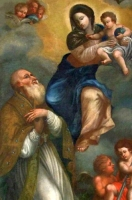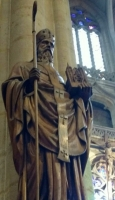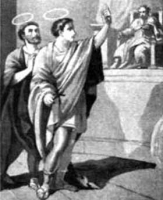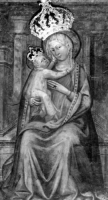St. Vincent of Leon
Feastday: September 11,march 11
Death: 554
Spanish abbot and martyr. The abbot of St. Claudius monastery in Leon, Spain, he was martyred by Arian Visigoths. There is some confusion as to the date of his death. Some lists state that he died about 630
St. Peter of Chavanon
Feastday: September 11
Birth: 1003
Death: 1080
Augustinian reformer and founder. Born at Langeac, in Haute Loire, France, he received ordination and served for a time as a priest in his native region. Later, he founded a monastery for Augustinian canons at Pebrac, Auvergne, using land which had been given to him. On the basis of the success of the house, he was asked to reform a number of cathedral chapters.
Blessed Charles Spinola
Also known as
Carlo Spinola
Profile
Born to the Italian nobility in a family that originated in Genoa. Studied at Nola, Italy, under his uncle Cardinal Filippo Spinola. Joined the Jesuits in Nola in 1584. Ordained in 1594. Missionary to Japan in 1594. It took three tries to actually reach the island, but he worked there for 18 years. Imprisoned and abused for his faith and his works in 1618. Spent four years living in a cage, bribing the guards with his food to obtain the necessities to conduct Mass. Martyred.
Born
c.1565 at Madrid, Spain
Died
slowly burned to death on 10 September 1622 at Nagasaki, Japan
Beatified
7 May 1867 by Pope Pius IX
Blessed Bonaventure of Barcelona
Also known as
• Bonaventure of Riudoms
• Bonaventura Gran
• Fra Bonaventure of Barcelona
• Miguel Baptista Gran Peris
Additional Memorial
24 November (Riudoms, Spain)
Profile
The only child in a farm family, Francisco married at age 18, but became a widower just sixteen months later. He then followed a call to religious life, and Franciscan friar at the convent of Sant Miquel d'Escornalbou, making his religious profession on 14 July 1641 and taking the name Bonaventura. Over the next 17 years, he was assigned to convents in Mora d'Ebre, Figueres, la Bisbal d'Empordà and Terrassa where he served variously as cook, porter, beggar and infirmarian, and was known for his quiet, pious devotion to work, prayer and Franciscan spirituality. In 1658 he was sent to the area of Rome, Italy, to promote a return to strict observance of the Franciscan Rule; he founded four monasteries in the region. He was assigned to houses in Aracaeli and Capranica, and served as porter at Saint Isidore's College. In 1662 he founded the Riformella, a reform movement of retreats and spiritual meditation for his brother friars to bring them back to the original Franciscan spirituality; his writings about the "Retreats" received pontifical approve from Pope Innocent XI. Over the years he served as advisor to many, including Pope Alexander VII, Pope Clement IX, Pope Clement X and Pope Innocent XI.
Born
• 24 November 1620 on Carrer de la Butxaca (Pocket Street) in Riudoms, Tarragona, Catalonia (in modern Spain) as Miguel Baptista Gran Peris
• the street where he was born has been re-named in his honour
Died
• 11 September 1684 at the friary of Saint Bonaventure on the Palantine Hill in Rome, Italy of natural causes
• buried at the friary
• relics transferred to Riudoms, Spain in 1972
• relics enshrined in the tabernacle chapel in the church of Saint James the Apostle in Riudoms
• relics are processed through the town of Riudoms each 24 November during a celebratory feast devoted to Blessed Bonaventure
Beatified
• 10 June 1906 by Pope Pius X
• his beatification miracles included the healing of a woman in 1790 from injuries sustained in a fall from a horse
• his beatification miracles included the healing of a woman in 1818 who had fallen into a coma for three days following childbirth, and was brought back to consciousness through prayer and the imposition of a relic of Blessed Bonaventure
Saint Jean-Gabriel Perboyre
Also known as
John Gabriel Perboyre
Profile
One of eight children born to Pierre Perboyre and Marie Rigal. At age 16 he followed his brother Louis to the seminary, and joined the Congregation of the Mission of Saint Vincent on Christmas Day 1818. Ordained in Paris on 23 September 1825. Professor of theology. Seminary rector. Assistant director of novices.
His brother died on a mission to China, and John Gabriel was asked to replace him. In March 1835 he sailed for China, and began his mission in Macao in June, 1836. A widespread persecution of Christians began in 1839, the same year England had attacked China. Father John Gabriel was denounced to the authorities by one of his catachumens, arrested, tried on 16 September 1839, tortured by hanging by his thumbs and flogging with bamboo rods, and condemned to death on 11 September 1840. Martyr. The first saint associated with China.
Born
6 January 1802 at Le Puech, near Mongesty, Cahors diocese, southern France
Died
lashed to a cross on a hill named the "red mountain", then strangled with a rope on 11 September 1840 at Ou-Tchang-Fou, China
Canonized
2 June 1996 by Pope John Paul II
Blessed Joan Roig i Diggle
Profile
Born to a poor family, the son of Ramón Roig Fuente and Maud Diggle Puckering. Educated by the La Salle Brothers, and then the Piarists. Student of Blessed Ignasi Casanovas Perramón and Blessed Francisco Carceller Galindo. To find work, his family moved to El Masnou, Spain, and while still in school, Joan worked as a store clerk and on a factory floor. Member of the Federación de Jóvenes Cristianos de Cataluña (Federation of Young Christians of Catalonia in El Masnou; he was soon entrusted with running the branch of the group devoted to children under 14. Known as a pious young man, Joan would spend hours lost in Eucharistic Adoration. Friend of Blessed Pere Tarrés i Claret. Entrusted with the Eucharist to bring Communion to the house-bound. During the Spanish Civil War, when the anti–Christian militia came to 'arrest' him for his faith, he quickly ate the Hosts to prevent desecration, hugged his mother, and left with his captors. He died forgiving and preaching to his killers. Martyr.
Born
12 May 1917 in Barcelona, Spain
Died
• shot multiple times over the night of 11 to 12 September 1936 in the cemetery of Sant Coloma de Gramenet, Barcelona, Spain
• interred in a chapel in the parish of San Pere de Masnou, Catalonia, Spain
Beatified
• 7 November 2020 by Pope Francis
• beatification recognition celebrated in the Basilica of Sagrada Familia in Barcelona, Spain
Saint Elijah Speleota
Also known as
• Elijah Bozzetta
• Elijah Espeleota
• Elia, Elias
Profile
Born to the wealthy nobility, the son of Peitro Bozzetta and Leonzia de Leontini. At age 18, to avoid an arranged marriage and answer a call to religious life, Elijah left home to become a pilgrim to Rome, Italy. He became a Basilian monk at Grottaferrata outside Rome, returned briefly to Reggio Calabria, and then he and a fellow monk name Arsenio travelled to Patras, Greece for further study. While they were away, Muslim Saracens invaded their home region, killing and enslaving Christians. When Elijah returned to Italy, he withdrew from populated areas to lived as a hermit in a cave near Melicuccà, Italy with two fellow monks, Cosma and Vitale; the word Speleota is Greek for “inhabitant of caves”. Word of their wisdom and holiness soon spread, and pilgrims regularly visited the caves for spiritual direction and advice.
Born
863 in Reggio Calabria, Italy
Died
• 11 September 960 at the Aulon monastery in Calabria, Italy of natural causes
• buried in the cave where he had dug his own grave with his hands
• on 2 August 1747, Antonio Germano unearthed his bones; the sight of them cured a serious medical ailment with which Antonio suffered
Our Lady of Coromoto
கொரோமோடோ புனித கன்னி மரியா
வெனிசுலா நாட்டில் உள்ள போர்த்துக்கியூசா மாகாணத்தில் உள்ளது குவானரே என்ற இடம். இங்கு 1591 ஆம் ஆண்டு ஒருசில மறைப்பணியாளர்கள் மறைப்பரப்பச் சென்றார்கள். இவர்களை பார்த்து விட்டு ஏற்கெனவே அங்கிருந்த கோஸ்பெஸ் கொரோமோடா இனத்தைச் சார்ந்தவர்கள் காடுகளுக்குத் தப்பியோடி, அங்கேயே வாழத் தொடங்கினார்கள்.
இதன்பிறகு 1651 ஆம் ஆண்டு புனித கன்னி மரியா கோஸ்பெஸ் கொரோமோடா இனக்குழுத் தலைவருக்கு ஓர் ஆற்றில் தோன்றி, "நீயும் உன்னுடைய இனத்தாரும் அருகே இருக்கும் மறைப்பணியாளர்களிடம் சென்று திருமுழுக்குப் பெற்றுக்கொள்ளுங்கள்" என்றார். உடனே இனக்குழு தலைவர் தன்னுடைய மக்களை மறைப்பணியாளர்களிடம்அழைத்துச் சென்று திருமுழுக்குப் பெறச் செய்தார்.
தன்னுடைய மக்களெல்லாம் மறைப்பணியாளர்களிடம் திருமுழுக்குப் பெற்றபொழுது அவர் மட்டும், 'நான் திருமுழுக்குப் பெற்றால் எனது பதவி பறிபோய்விடுமே' என அஞ்சித் திருமுழுக்கு பெறாமலேயே இருந்தார்.
1652 ஆம் ஆண்டு செப்டம்பர் திங்கள் 8 ஆம் நாள் புனித கன்னி மரியா கோஸ்பெஸ் இனக்குழுத் தலைவருக்குத் மீண்டுமாக தோன்றி, திருமுழுக்குப் பெறுமாறு சொன்ன பொழுது, அவர் புனித கன்னி மரியாவைப் பிடிக்க முயன்றார். அப்பொழுது புனித கன்னி மரியா தன்னுடைய திருவுருவம் பதித்த ஓர் ஓவியத்தை அங்கு விட்டுவிட்டு, அங்கிருந்து மறைந்து போனார். அதுதான் கொரோமோடோ புனித கன்னி மரியாவின் திருவுருவம்.
இவ்வாறு திருமுழுக்கு பெறாமலேயே இருந்த கோஸ்பெஸ் இனக்குழுத் தலைவர், தன்னுடைய வாழ்வின் இறுதிக்கட்டத்தில் திருமுழுக்குப் பெற்று ஆண்டவர்மீதும் புனித கன்னி மரியாவின் மீதும் நம்பிக்கை கொள்ளத் தொடங்கினார்.
1942 ஆம் ஆண்டு வெனிசுலா நாட்டு ஆயர்கள் கொரோமோடா புனித கன்னிமரியாவை வெனிசுலா நாட்டின் பாதுகாவலியாக அறிவித்தார்கள். 1944 ஆம் ஆண்டு அக்டோபர் 7 ஆம் நாள் திருத்தந்தை பன்னிரண்டாம் பயஸ் இதை உறுதி செய்தார். 1996 ஆம் ஆண்டு குவானரே என்ற இடத்தில் இருந்த கொரோமோடோ புனித கன்னி மரியாவின் திருத்தலம் தேசியத் திருத்தலமாக அறிவிக்கப்பட்டது. திருத்தந்தை பதினாறாம் பெனடிக்ட்டோ இதனைப் பெருங்கோயில் (Basilica) என்று அறிவித்தார்.
Also known as
• Nuestra Señora de Coromoto
• Virgin of Coromoto
• Virgen de Coromoto
Additional Memorials
• 2 February
• 8 September
Apparition
8 September 1652 at Guanare, Portuguesa, Venezuela
Approval
1950 by Pope Pius XII
Article
Commemorates the apparition of the Blessed Virgin Mary to Coromoto, leader of the indigenous people in the forests near Guanare, Venezuela. Our Lady told the chief and his wife to go to the Catholic missionaries in the city, learn the faith, and receive Baptism; Coromoto shot an arrow at her, she vanished, and left behind a piece of paper with her portrait. The entire tribe, except for Coromoto himself, converted to Christianity; he was afraid of losing his standing in the tribe. Tradition says that he fled from the Baptism ceremony into the forest where he was bitten by a poisonous snake; this could be allegorical.
Saint Paphnutius of Thebes
புனித பாப்னுடீயஸ், (ஆயர்)
நினைவுத் திருநாள் : செப்டம்பர் 11
இவர் பல ஆண்டுகள் பாலைவனத்தின் வாழ்ந்தார். பிறகு குருவாக திருநிலைப்படுத்தப்பட்டு எகிப்து நாட்டில் ஆயராகவும் தேர்ந்தெடுக்கப்பட்டார். தன் மறைமாநில மக்கள் பாவமன்னிப்பு பெற வேண்டுமென்று விரும்பினார். இதன் வழியாக அமைதியை நிலை நாட்ட எண்ணினார். அதற்காக பெரிதும் உழைத்து, தம் மந்தையை மனந்திருப்பினார். பின்னர் தம் மக்களை நல்ல கிறிஸ்துவர்களாக வளர்த்தெடுத்தார். பல பாவமன்னிப்பு வழிபாடு வழங்கி , மக்களின் மனதை முழுவதுமாக இறைவன் பால் திருப்பினார்.
அப்போது 325 ஆம் ஆண்டு கான்ஸ்டாண்டின்(Constantine) என்ற அரசன் ஓர் கூட்டத்தை கூட்டினான். ஆயர் பாப்னுடீயஸை அக்கூட்டத்திற்கு வரவழைத்தான். தனக்கு தனிபட்ட முறையில் அனைவர் முன்னிலையிலும் மரியாதை அளிக்கும்படி ஆயரிடம் கட்டளையிட்டார்ன். ஆனால் ஆயர் அதை செய்ய மறுத்தார். இதனால் அரசன் கோபங்கொண்டு ஆயரின் வலது கண்ணை பிடுங்கி எரிந்தான். அக்கூட்டத்தில் திருச்சபைக்காக தன் கண்ணை இழந்தார் ஆயர். ஒரு கண்ணைக் கொண்டே 355 ஆம் ஆண்டு மீண்டும் தொழிற்சங்கக் கூட்டத்திற்கு வந்தார். அப்போதுதான் நோய்வாய்ப்பட்டு உடல்நலம் குன்றி இறந்தார்.
Also known as
• Paphnutius of Egypt
• Paphnutius the Confessor
• Pafnucius...
Profile
Hermit. Spiritual student of Saint Anthony the Abbot. Monk. Bishop in Egypt. During the persecutions of emperor Galerius Maximinus, Paphnutius had his right eye torn out, his left knee crippled, and was sent to work in the mines, all as punishment for his faith. Rescued by emperor Constantine the Great in 313, Paphnutius resumed his pastoral duties and worked against Arianism heresy. Participated in the Council of Nicea, and afterwards worked to spread the Nicene Creed. Attended the Council of Tyre in 335 where he again had to oppose Arianism.
Blessed José María Segura Panadés
Profile
Studied at the seminary of Valencia, Spain, and ordained a priest in the archdiocese of Valencia on 12 June 1921. Co-adjutor of Adzaneta de Albaida. Co-adjutor in Santa María de Onteniente. Noted for his work in youth ministry. Martyred in the Spanish Civil War for the crime of being a priest.
Born
13 October 1896 in Ontinyent, Valencia, Spain
Died
shot on 11 September 1936 in Genovés, Valencia, Spain
Beatified
11 March 2001 by Pope John Paul II
Blessed François Mayaudon
Profile
Baptised at the age of two days. Priest in the diocese of Soissons, France. Imprisoned on a ship in the harbor of Rochefort, France and left to die during the anti-Catholic persecutions of the French Revolution. One of the Martyrs of the Hulks of Rochefort.
Born
2 May 1739 in Terrasson, Dordogne, France
Died
11 September 1794 aboard the prison ship Deux-Associés, in Rochefort, Charente-Maritime, France of gangrene
Beatified
1 October 1995 by Pope John Paul II
Saint Sacerdos of Lyon
Also known as
Sardot, Serdon
Profile
Son of Saint Rusticus of Lyon and Hiberie de Limoges; nephew of Saint Viventiolus of Lyon; uncle of Saint Nicetius of Lyon; father of Saint Aurelian of Arles. Bishop of Lyon, France from 549 to 552. Presided over the Council of Orleans in 549. Advisor to King Childebert I.
Born
487
Died
• 11 September 552 at Paris, France of natural causes
• buried in the church of the Apostles (later renamed the church of Saint Nicholas), Lyon, France
Saint Leudinus of Toul
Also known as
Leudinus Bodo, Leudin, Bodon
Profile
Born to the nobility, the son of Duke Gundoin of Alsace and Saratrude of the Etichonids; brother of Saint Salaberga. Married to a pious woman named Odile. He and his wife each felt a call to religious life; Odile became a nun, Leudinus a Benedictine monk at Laon, France. Founded the French monasteries of Etival, Bon-Moutier and Affonville. Bishop of Toul, Austrasia (in modern France) c.669.
Born
c.625 in Bassigny, Austrasia (in modern France)
Died
• c.673 of natural causes
• buried in the crypt of Saint Mansuy
Saint Deiniol of Bangor
Also known as
Daniel
Profile
Son of a Celtic chieftain, possibly from the area of Strathclyde, Scotland; related to Saint Asaph of Llanelwy. Founded monasteries in Gwynedd and Flintshire. First bishop of Bangor, Wales, consecrated by Saint Dubritius. An evangelist and excellent shepherd of his people. Worked with Saint David of Wales. The cathedral of Bangor and several other churches were named in his honour.
Died
• c.565 of natural causes
• buried on Bardsey Island
Saint Theodora the Penitent
Profile
A Christian woman, she fell into a life of sin for many years, had a conversion experience, returned to her faith, and lived the rest of her life as a penitent hermit in the deserts of Thebaid, Egypt. Living the rugged like of a desert hermit, no one knew she was a woman until she died and they were preparing her for burial.
Born
Alexandria, Egypt
Died
491 of natural causes
Saint Hyacinth of Rome
Profile
Brother of Saint Protus of Rome. Servant in the house of Saint Eugenia in Rome, Italy. Arrested and martyred for their faith. Pope Saint Damasus wrote their epitaph.
Died
• burned alive c.257 at Rome, Italy
• buried in the cemetery of Saint Basilla, Rome
• relics transferred to the church of San Giovanni dei Fiorentini
Saint Sperandea
Also known as
Sperandia
Profile
Relative of Saint Ubaldus Baldassini. Benedictine nun at Cingoli, Ancona, Papal States (modern Italy). Abbess. Mystic who received visions, one of whom told her to dress in a tanned pigskin with the bristles against her skin, and to use a chain for a belt.
Died
• 1276 of natural causes
• body incorrupt
Saint Protus of Rome
Profile
Brother of Saint Hyacinth of Rome. Servant in the house of Saint Eugenia in Rome, Italy. Arrested and martyred for their faith. Pope Saint Damasus wrote their epitaph.
Died
• burned alive c.257 at Rome, Italy
• buried in the cemetery of Saint Basilla, Rome
• relics transferred to the church of San Giovanni dei Fiorentini
Blessed Baldassarre Velasquez
Profile
Mercedarian friar. Imprisoned by Saracens in La Muela, Zaragoza, Spain, and ordered by them to renounce Christianiity. Instead, Baldassarre began preaching against them, their vices, their wickedness. He was then executed with 16 other Christians whose names have not come down to us. Martyr.
Died
with arrows in 1588
Blessed Francesco Giovanni Bonifacio
Profile
Priest in the diocese of Trieste, Italy. Martyr.
Born
7 September 1912 in Piran, Istarska, Italy (now in Croatia)
Died
11 September 1946 at Villa Gardossi, Krasica, Istarska, Italy (now in Croatia)
Beatified
4 October 2008 by Pope Benedict XVI
Saint Matthew of Gravedona sul Lario
Profile
May have been a soldier in the Theban Legion. Martyr.
Died
• relics re-discovered on 11 September 1248 and enshrined at the church of San Fedele
• church re-built in 1533 and re-named for Santi Gusmeo and Matthew
• relics re-enshrined under the main altar in a marble urn in 1637
Saint Gusmeo of Gravedona sul Lario
Profile
May have been a soldier in the Theban Legion. Martyr.
Died
• relics re-discovered on 11 September 1248 and enshrined at the church of San Fedele
• church re-built in 1533 and re-named for Santi Gusmeo and Matthew
• relics re-enshrined under the main altar in a marble urn in 1637
Blessed Franciscus Takeya
Additional Memorial
10 September as one of the 205 Martyrs of Japan
Profile
Son of Blessed Cosmas Takeya Sozaburo and Blessed Agnes Takeya in the archdiocese of Nagasaki, Japan. Martyred at age 12.
Born
1610 in Nagasaki, Japan
Died
beheaded on 11 September 1622 in Nishizaka, Nagasaki, Japan
Beatified
7 May 1867 by Pope Blessed Pius IX
Blessed Bonincontri of San Miniato
Also known as
Bonincontro
Profile
A spiritual student of Saint Francis of Assisi, Bonincontri was one of the first Franciscan friars, helping found the Castrum Rudilphi convent in the diocese of Bourges, France. Known as a miracle worker.
Born
latter 12th century
Died
1230 of natural causes
Saint Emilian of Vercelli
Also known as
Aemilian of Vercelli
Profile
Lived as a hermit for 40 years. Bishop of Vercelli, Italy. Attended three synods held in Rome, Italy by Pope Saint Symmachus. Lived to be over 100.
Died
• 520 in Vercelli, Italy of natural causes
• relics translated in 1181
• relics translated in late 17th century
Blessed Gaspar Koteda
Additional Memorial
10 September as one of the 205 Martyrs of Japan
Profile
Young layman catechist in the archdiocese of Nagasaki, Japan. Dominican tertiary. Martyr.
Born
1601 in Nagasaki, Japan
Died
beheaded on 11 September 1622 in Nishizaka, Nagasaki, Japan
Beatified
7 May 1867 by Pope Blessed Pius IX
Blessed Petrus Kawano
Additional Memorial
10 September as one of the 205 Martyrs of Japan
Profile
Son of Blessed Marina Tanaura in the archdiocese of Nagasaki, Japan. Martyred at age 7.
Born
1615 in Nagasaki, Japan
Died
beheaded on 11 September 1622 in Nishizaka, Nagasaki, Japan
Beatified
7 May 1867 by Pope Blessed Pius IX
Saint Essuperanzio of Zurich
Profile
Servant of Saint Regula and Saint Felix of Zurch. During the persecutions of Maximian Herculeaus the two fled to Switzerland. They were found there near Zurich. Martyr.
Died
3rd century near Zurich, Switzerland
Saint Regula of Zurich
Profile
Sister of Saint Felix of Zurich. During the persecutions of Maximian Herculeaus the two fled to Switzerland. They were found there near Zurich. Martyr.
Died
martyred in the 3rd century near Zurich, Switzerland
Saint Felix of Zurich
Profile
Brother of Saint Regula of Zurich. During the persecutions of Maximian Herculeaus the two fled to Switzerland. They were found there near Zurich. Martyr.
Died
3rd century near Zurich, Switzerland
Blessed Thomas Bathe
Additional Memorial
20 June as one of the Irish Martyrs
Profile
Priest in the archdiocese of Armagh, Ireland.
Born
Irish
Died
martyred on 11 September 1649 in Drogheda, Louth, Ireland
Beatified
27 September 1992 by Pope John Paul II in Rome, Italy
Blessed Dominic Dillon
Additional Memorial
20 June as one of the Irish Martyrs
Profile
Dominican priest. One of the Irish Martyrs.
Born
Irish
Died
11 September 1649 in Drogheda, Louth, Ireland
Beatified
27 September 1992 by Pope John Paul II in Rome, Italy
Blessed Richard Overton
Additional Memorial
20 June as one of the Irish Martyrs
Profile
Dominican priest.
Born
Irish
Died
martyred on 11 September 1649 in Drogheda, Louth, Ireland
Beatified
27 September 1992 by Pope John Paul II in Rome, Italy
Blessed John Bathe
Additional Memorial
20 June as one of the Irish Martyrs
Profile
Jesuit priest. One of the Irish Martyrs.
Born
Irish
Died
11 September 1649 in Drogheda, Louth, Ireland
Beatified
27 September 1992 by Pope John Paul II in Rome, Italy
Blessed Peter Taaffe
Additional Memorial
20 June as one of the Irish Martyrs
Profile
Augustinian priest.
Born
Irish
Died
martyred on 11 September 1649 in Drogheda, Louth, Ireland
Beatified
27 September 1992 by Pope John Paul II in Rome, Italy
Saint Patiens of Lyon
Profile
Archbishop of Lyon, France. Worked with, and was highly praised by Saint Sidonius Apollinaris. Bishop Patiens donated all his income to the poor.
Died
c.491
Saint Almirus
Also known as
Almer, Almire
Profile
Hermit at Gréez-sur-Roc, France.
Born
Auvergne, France
Died
c.560 at Gréez-sur-Roc, France
Saint Adelphus of Remiremont
Profile
Grandson of Saint Romaricus. Monk and then abbot of Remiremont Abbey in eastern France.
Died
c.670
Martyred in the Spanish Civil War
• Blessed José Piquer Arnáu
• Blessed Josep Pla Arasa
• Blessed Lorenzo Villanueva Larrayoz
Also celebrated but no entry yet
• Louis IV, Landgrave of Thuringia




































